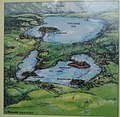Lieps (lake)
| Lieps | ||
|---|---|---|

|
||
| The island of Hanfwerder on the Lieps | ||
| Geographical location | Mecklenburg-Western Pomerania | |
| Tributaries | small brooks, etc. a. Ziemenbach | |
| Drain | Canals (e.g. "Alter Graben" and "Neuer Graben") to the Tollensesee |
|
| Islands | Hanfwerder , Kietzwerder | |
| Places on the shore | Prillwitz | |
| Location close to the shore | Neubrandenburg | |
| Data | ||
| Coordinates | 53 ° 27 '4 " N , 13 ° 9' 26" E | |
|
|
||
| Altitude above sea level | 14.8 m above sea level NHN | |
| surface | 4.31 km² | |
| length | 2,899 km | |
| width | 2.47 km | |
| volume | 9,700,000 m³ | |
| Maximum depth | 3.8 m | |
| Middle deep | 2.3 m | |
| PH value | 8.8 | |
| Catchment area | 82.6 km² | |
|
particularities |
The presumed location of the Slavic sanctuary Rethra ; One of the most important bird sanctuaries inland |
|
The Lieps is a lake in Mecklenburg-Western Pomerania , Germany. The name of the lake comes from the Slavic "Lipa" ("linden tree").
geography
The Lieps belongs to the area of the city of Neubrandenburg and is only a few hundred meters south of Lake Tollensee . It is connected to this lake to the north via canals (e.g. "Alter Graben"). The Lieps, which is mainly fed by the Ziemenbach and the Eichseebach (Zippelower Bach), is 3 kilometers long and 2.5 kilometers wide. The latter tributary is part of the historic Landwehr Isern Purt , the Gau border of the Retharians . The average water depth is 2.3 meters. Its catchment area is 82.6 km² and is predominantly agricultural. The Lieps is part of the Nonnenhof nature reserve .
General
On the banks of the Lieps lies the Prillwitz hunting lodge , from which you can overlook the Nonnenhof peninsula with the Bacherswall and the islands of Hanf- and Kietzwerder . In the area of Tollensesee and Lieps, the Slavic central sanctuary Rethra has been suspected and searched for centuries , without having been able to prove it. Due to the damming of the water level in the 13th century by about 1.5 meters for the operation of the four-wheel mill , numerous Slavic cultural remains are now below the waterline. The island of Binsenwerder is completely flooded today. In underwater excavations in the Lieps, as well as in investigations on the islands and the fortifications on the Nonnenhof peninsula, permanent settlement since the 7th century has been proven. In the late Slavic era, an early urban settlement center of outstanding historical dimensions developed here. The most important find from the Tollensesee-Lieps area is a double-headed Slavic wooden idol that was excavated in 1969 on the fishing island in the Tollensesee. Many Slavic finds from this area can be viewed today in the Regional Museum in Neubrandenburg . A holiday complex with Swedish houses has been under construction since 2014, adjacent to the Lieps and the southeastern shore of Lake Tollensee .
Chemical and trophic characteristics
The Lieps is a polymictic flat lake. The average pH value of 8.8 shows it to be weakly alkaline . According to the 1993 water quality report (LAUN MV and StAUN MV 1993), there were high oxygen concentrations down to the bottom all year round. The Lieps are characterized by their high calcium carbonate concentration of over 1 g / l , which presumably eliminates the high levels of phosphorus. The total phosphorus concentration was only 80 μg / l, but in the summer months locally and near the surface it was also up to 118 μg / l. The total nitrogen concentration was 1.5 mg / l. These parameters identified the lake as eutrophic . For the following years up to 2001 a change in the trophy to high polytrophic was registered. This change went hand in hand with the increase in the chlorophyll a concentration up to a maximum of 107 μg / l (1998), the temporary increase in the phosphorus concentration up to 180 μg / l (59-180 μg / l) and the decrease in the calcium carbonate content by about half of its initial value from 1993.
In the summer of 1998, algae specialists from the Leibniz Institute for Freshwater Ecology and Inland Fisheries (IGB) detected the subtropical and tropical blue algae species Cylindrospermopsis raciborskii , Anabaenopsis elenkinii and Aphanizomenon issatschenkoi in the Lieps since they were first detected in 1990. The Lieps is the northernmost known location of the species Cylindrospermopsis raciborskii .
Hunting lodge Prillwitz on the western bank of the Lieps
See also
Web links
Individual evidence
- ↑ a b c d e f g h Documentation of the condition and development of the most important lakes in Germany: Part 2 Mecklenburg-Western Pomerania (PDF; 3.5 MB)
- ↑ Swedish houses on Lake Tollensesee, Nonnenhof nature reserve ( memento from December 23, 2014 in the Internet Archive ) - holiday homes of MEBRA Projektentwicklungs GmbH
- ↑ Information Service Science




